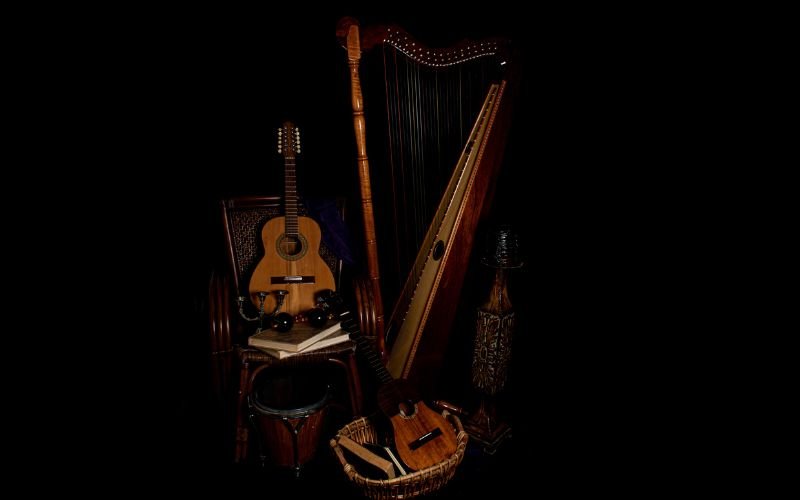All you need to know about the origins of musical instruments
Whether you're a professional musician or an amateur, you're intimately linked to your favorite instrument, whether it's the guitar, piano, violin, flute or clarinet. But do you know the story behind the invention of the first musical instruments? What was the first stringed instrument? How did the first wind instruments come into being? Join us on a journey through time and discover the origins of musical instruments, from the depths of prehistoric caves to the digital age.
First instruments: what if the origin of music was in a cave?
The origins of musical instruments date back to the dawn of our existence. Archaeological discoveries provide precious evidence of the beginnings of music. Among the artifacts unearthed, bone whistles and animal skin drums stand out as the first man-made instruments. These simple objects, dating back thousands of years, carry within them the first notes of our modern musical instruments.
Drums, with their regular beat, were among the first means of musical expression created. Made from rudimentary materials, these instruments gave rhythm to the lives of early communities, accompanying ritual ceremonies in particular.
The ancestors of the flute, bone whistles represent another milestone in the evolution of musical instruments. Carved from animal bones, these small instruments enabled Man to produce his first melodies.
💡 Did you know? Dating back to prehistoric times, the earliest known wind instrument is the Hohle Fels flute carved from the bones of a vulture, discovered in a cave in Germany. This ancient flute bears witness to the distant origins of music, illustrating the ingenuity and creativity of our ancestors in their quest for artistic expression.
The evolution of musical instruments in antiquity
Antiquity was a time of greatness and creativity, when iconic civilizations such as Egypt, Greece and Rome flourished. At the heart of these societies, music played a key role in daily life, religious rituals and entertainment.
Ancient Egypt: an era of divine music
Ancient Egypt, the cradle of civilization for thousands of years, left the world a rich and varied musical heritage. Frescoes in royal tombs reveal the use of harps, flutes, oboes and percussion instruments in religious ceremonies and royal festivities. The harp in particular, a symbol of refinement, was often associated with the goddess Hathor, protector of music and dance.
Ancient Greece: between sacred music and mythology
Ancient Greece, famous for its philosophy, was also a hotbed of musical creativity. The lyre, a plucked string instrument, was one of the most emblematic instruments of ancient Greece, playing a central role in music and poetry. Great musicians and thinkers such as Orpheus and Pythagoras contributed to the development of music, exploring theories of harmony and composition.
Ancient Rome: the imperial musical legacy
In the Roman Empire, music played an important role in social and cultural life. The Romans borrowed and adapted many instruments from Greece and other cultures, while developing their own musical traditions. The flute, for example, was often used in religious ceremonies and public entertainments.
Focus on the Middle Ages and religious music
At the heart of the Middle Ages, religious music dominated the sound landscape of Europe. The influence of religious music on the development of instruments was immense, with innovations such as the organ becoming the musical soul of medieval churches. Alongside the organ, other instruments such as the harp, psaltery and hurdy-gurdy were used to accompany liturgical chants and religious ceremonies. Gradually, these instruments evolved in size, shape and sound, reflecting the aesthetic and technical changes of the medieval era.
The emergence of new musical instruments during the Renaissance
The Renaissance was a highly charged artistic and intellectual period, when music flourished in all its splendor. New types of instrument appeared, such as the violin, lute and viola da gamba, opening up new possibilities for musical expression.
The violin and lute were among the most emblematic instruments of the Renaissance, embodying the innovative spirit and artistic richness of the period. The violin, with its lively, expressive sound, became the flagship instrument of orchestras and chamber ensembles, while the lute, with its delicate plucked strings, seduced royal courts and aristocratic salons.
A lute
💡 Did you know? The origin of the first orchestra dates back to the Court of Louis XIV in France. Under the direction of Jean-Baptiste Lully, the 24 Violons du Roi are often referred to as the first orchestra in history. Initially made up of violins, the ensemble gradually expanded to include woodwinds, brass and percussion.
The impact of the Industrial Revolution on the manufacture of musical instruments
The Industrial Revolution transformed the way musical instruments were made. Mass production techniques enabled faster, cheaper manufacture, making musical instruments accessible to a wider range of people. At the same time, the introduction of new materials led to significant improvements in instrument quality and sound.
Over the course of the 19th and 20th centuries, numerous innovations left their mark on the world of music. One of the most emblematic inventions of this period was the grand piano, designed to offer a richer sound and better resonance than its predecessor, the upright. This innovation enabled composers and performers to explore new musical horizons, and contributed to the evolution of the piano repertoire.
Another revolutionary instrument of this era is the saxophone, invented by Adolphe Sax in the mid-19th century. With its powerful, expressive sound, the saxophone has become a central element in many musical genres, from classical to jazz and rock.
🎻 Is music a real passion for you, or are you simply curious to learn more about musical instruments? Then head for Belgium! Located in Brussels, the Musée des Instruments de Musique (MIM) houses an exceptional collection of rare and more modern musical instruments from the four corners of the globe.
Reinventing music in the digital age
The advent of the digital age has brought about an unprecedented revolution in the world of music. Technological advances have redefined the way music is created, produced and distributed, opening the way to new forms of artistic expression for musicians worldwide.
The digital revolution has radically transformed the music creation and production process. Computers and specialized computer-aided music software (CAM) now offer musicians a powerful arsenal of tools for composing, arranging and recording their music with unrivalled precision and flexibility. What's more, digital production techniques make it possible to explore new sonic horizons and push back the boundaries of artistic creativity.
Digital software and musical instruments: a new frontier in musical expression
Digital musical instruments represent a major innovation in the music industry. From MIDI keyboards and pads to pad controllers and virtual synthesizers, these devices offer musicians an infinite palette of sounds and effects to explore. By combining the power of digital technology with human artistic sensibility, digital musical instruments open up new possibilities for musical expression and live performance.
Music production software has become an indispensable part of the music creation process. From sequencers and digital audio workstations (DAWs) to effects and sound processing plug-ins, these tools give producers and sound engineers total control over every aspect of music production. What's more, online collaboration platforms make it easy for musicians to work together, no matter where they are in the world.
Classification of musical instruments: what are their origins?
The classification of musical instruments dates back to antiquity, with Aristotle's first attempts to group instruments according to their mode of sound production. Over the centuries, this classification was refined, incorporating aesthetic and cultural criteria in the Middle Ages and Renaissance, and becoming more complex in modern times with the development of musicology.
There are four main families of musical instruments:
stringed instruments,
wind instruments,
percussion instruments,
electronic instruments.
Stringed instruments, such as the violin or guitar, produce sound by vibrating through taut strings. Wind instruments, such as the flute or saxophone, produce sound through the vibration of air. Percussion instruments, such as drums and maracas, produce sound through the contact and vibration of materials. Finally, electronic instruments use electronic circuits to generate and modify sounds, such as synthesizers or drum machines.
🎶 Do you play in a band or take lessons with a private teacher? With theNewzik application, you can find all your scores saved in your personal library. Annotate, comment and share your scores in real time. Thanks to Newzik's interactive score reader, solo or group playing has never been so easy!







